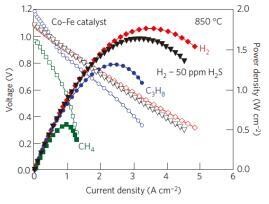hankyoreh
Links to other country sites 다른 나라 사이트 링크
S. Korean researchers develop new fuel cell using natural gas

South Korean researchers have developed a new kind of electrode for fuel cells that can generate electricity straight from natural gas. In effect, the discovery represents another step closer toward the developing fuel cells that could be used to create electricity at home like a boiler.
The Ulsan National Institute of Science and Technology (UNIST) announced that a team of researchers led by Kim Geon-tae, professor of energy and chemical engineering, had developed a new material for a solid oxide fuel cell, which produces electricity solely from hydrogen and air. A paper detailing the research was published in the Dec. 23 issue of Nature Materials, an international scientific journal in the area of material science, the university said.
A solid oxide fuel cell is a kind of technology that produces electricity and water through a reaction between water and hydrogen or hydrocarbons such as liquefied natural gas (LNG) and liquefied petroleum gas (LPG). These fuel cells are considered to be among the most efficient of the new forms of energy at generating power (95% and above).

Such fuel cells have a number of disadvantages, however. Since carbon adheres to the electrode through which the fuel is supplied and since the sulfur contained in the fuel causes corrosion, the fuel cells’ performance suffers and they cannot be used for long.
In the experiment, the researchers made the fuel electrode with a new multi-layer substance called perovskite. When they tested the cell at 700 degrees Celsius using propane (a kind of natural gas) as fuel, they found that carbon did not adhere to the electrode and that the cell performed three times better than those whose electrodes were made of existing materials. The researchers were able to maintain this level of performance for more than 500 hours.
“The global market for power generating fuel cells is projected to be worth 6.8 trillion won (US$6.19 billion) in 2020. But if this new material is used in electrodes, the manufacturing cost of fuel cells could be cut by 500 billion won (US$455.56 million), and that’s a conservative estimate,” said Kim Geon-tae.
By Lee Geun-young, science correspondent
Please direct questions or comments to [english@hani.co.kr]

Editorial・opinion
![[Column] Season 2 of special prosecutor probe may be coming to Korea soon [Column] Season 2 of special prosecutor probe may be coming to Korea soon](https://flexible.img.hani.co.kr/flexible/normal/500/300/imgdb/original/2024/0426/3317141030699447.jpg) [Column] Season 2 of special prosecutor probe may be coming to Korea soon
[Column] Season 2 of special prosecutor probe may be coming to Korea soon![[Column] Park Geun-hye déjà vu in Yoon Suk-yeol [Column] Park Geun-hye déjà vu in Yoon Suk-yeol](https://flexible.img.hani.co.kr/flexible/normal/500/300/imgdb/original/2024/0424/651713945113788.jpg) [Column] Park Geun-hye déjà vu in Yoon Suk-yeol
[Column] Park Geun-hye déjà vu in Yoon Suk-yeol- [Editorial] New weight of N. Korea’s nuclear threats makes dialogue all the more urgent
- [Guest essay] The real reason Korea’s new right wants to dub Rhee a founding father
- [Column] ‘Choson’: Is it time we start referring to N. Korea in its own terms?
- [Editorial] Japan’s rewriting of history with Korea has gone too far
- [Column] The president’s questionable capacity for dialogue
- [Column] Are chaebol firms just pizza pies for families to divvy up as they please?
- [Column] Has Korea, too, crossed the Rubicon on China?
- [Correspondent’s column] In Japan’s alliance with US, echoes of its past alliances with UK
Most viewed articles
- 1[Column] Season 2 of special prosecutor probe may be coming to Korea soon
- 2‘We must say no’: Seoul defense chief on Korean, USFK involvement in hypothetical Taiwan crisis
- 3Is N. Korea threatening to test nukes in response to possible new US-led sanctions body?
- 4Division commander ordered troops to enter raging flood waters before Marine died, survivor says
- 5Amnesty notes ‘erosion’ of freedom of expression in Korea in annual human rights report
- 6Is Japan about to snatch control of Line messenger from Korea’s Naver?
- 7No good, very bad game for Korea puts it out of Olympics for first time since 1988
- 8[Editorial] Korea’s surprise Q1 growth requires objective assessment, not blind fanfare
- 9N. Korean delegation’s trip to Iran shows how Pyongyang is leveraging ties with Moscow
- 10Korea’s 1.3% growth in Q1 signals ‘textbook’ return to growth, says government